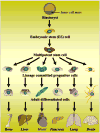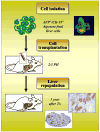Stem cells, cell transplantation and liver repopulation
- PMID: 18187050
- PMCID: PMC2857398
- DOI: 10.1016/j.bbadis.2007.12.004
Stem cells, cell transplantation and liver repopulation
Abstract
Liver transplantation is currently the only therapeutic option for patients with end-stage chronic liver disease and for severe acute liver failure. Because of limited donor availability, attention has been focused on the possibility to restore liver mass and function through cell transplantation. Stem cells are a promising source for liver repopulation after cell transplantation, but whether or not the adult mammalian liver contains hepatic stem cells is highly controversial. Part of the problem is that proliferation of mature adult hepatocytes is sufficient to regenerate the liver after two-thirds partial hepatectomy or acute toxic liver injury and participation of stem cells is not required. However, under conditions in which hepatocyte proliferation is blocked, undifferentiated epithelial cells in the periportal areas, called "oval cells", proliferate, differentiate into hepatocytes and restore liver mass. These cells are referred to as facultative liver stem cells, but they do not repopulate the normal liver after their transplantation. In contrast, epithelial cells isolated from the early fetal liver can effectively repopulate the normal liver, but they are already traversing the hepatic lineage and may not be true stem cells. Mesenchymal stem cells and embryonic stem cells can be induced to differentiate along the hepatic lineage in culture, but at present these cells are inefficient in repopulating the liver. This review will characterize these various cell types and compare the properties of these cells and the conditions under which they do or do not repopulate the liver following their transplantation.
Figures



References
-
- Thomson JA, Itskovitz-Eldor J, Shapiro SS, Waknitz MA, Swiergiel JJ, Marshall VS, Jones JM. Embryonic stem cell lines derived from human blastocyst. Science. 1998;282:1145–1147. - PubMed
-
- Fuchs E, Segre JA. Stem cells: a new lease on life. Cell. 2000;100:143–155. - PubMed
-
- Weissman I. Stem cells: units of development, units of regeneration, and units in evolution. Cell. 2000;100:157–168. - PubMed
-
- Marshman E, Booth C, Potten CS. The intestinal epithelial stem cell. Bioessays. 2002;4:91–98. - PubMed
-
- Sherley JL. Asymmetric cell kinetics genes: the key to expansion of adult stem cells in culture. Stem Cells. 2002;20:561–572. - PubMed
Publication types
MeSH terms
Substances
Grants and funding
LinkOut - more resources
Full Text Sources
Other Literature Sources
Medical

